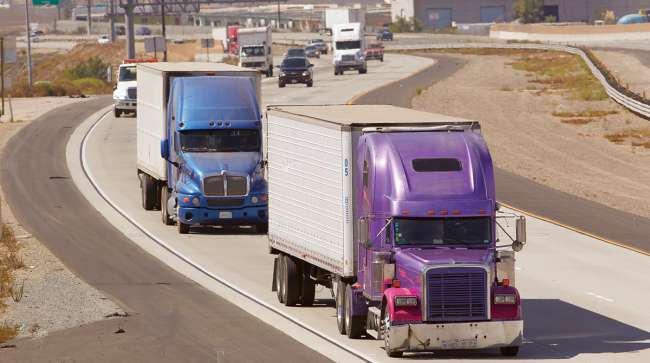Staff Reporter
Disruptions Add More Stress to Already Strained Capacity Market

[Stay on top of transportation news: Get TTNews in your inbox.]
Already stressed capacity is facing new pressure as the economy recovers from the coronavirus pandemic and demand increases.
“There are short-term and longer-term implications,” Noah Hoffman, vice president of retail and supply chain solutions at C.H. Robinson, told Transport Topics. “The retail space continues to put demand on all suppliers. The retail community can’t keep up with both inbound and outbound constraints and e-commerce continues to fuel that space. So certain inventory for retailers are at record lows. This is going to compound the demands on capacity that’s already not readily available.”
Hoffman highlighted several current trends adding additional pressure to capacity. He noted retailers are still trying to build their inventories, the government stimulus is driving economic growth and distribution of the coronavirus vaccine is helping to open up more of the economy. There are also changes in purchasing patterns complicating different modes like a shift toward home goods, electronics and garden supplies. There is also construction and ongoing infrastructure spending.
“What we’re seeing right now versus last year is capacity is coming back,” Hoffman said. “This is positive news. The thing is it’s just not fast enough to keep up with demand.”
Hoffman added much of that capacity growth is coming from smaller carriers. He noted that around this time last year a lot of supply was stripped from the marketplace because of lockdowns, truckload carriers parking equipment and drivers sitting at home. So, while capacity isn’t keeping up with demand, it is improving.
“As it relates to the Southeast region of the U.S., we had the cold snap in February,” Hoffman said. “That delayed the produce season. Call it two to three weeks. On top of that, we had a rebound floral season that led to a $2.6 billion Mother’s Day and floral season, which is a record high. And so you have compounding volumes of looming produce season, a booming floral season that puts a ton of pressure on the temp control capacity.”

Next-level technologies hold the potential to enhance safety and efficiency in transportation, but it takes a lot of work behind the scenes to advance these ideas from concept to reality. We talk with Christoph Mertz of the Robotics Institute at Carnegie Mellon and Huei Peng of the University of Michigan. Hear a snippet above, and get the full program by going to RoadSigns.TTNews.com.
Hoffman warned even the short-lived disruptions can have long-term implications. With how stressed the markets are, their effects can ripple and compound upon other issues. So while the economy is still dealing with problems from weeks ago, new issues such as pallet availability and the oil pipeline shutdowns are arising.
C.H. Robinson ranks No. 1 on the Transport Topics Top 50 list of the largest logistics companies in North America.
“I would say it’s not only just the increase in the demand, it’s the volatility and the unanticipated levels of demand,” Douglas Kent, executive vice president of strategy and alliances at the Association for Supply Chain Management, told TT. “Managing the supply chain networks for known demand is much easier than managing unknown demand. So we’ve got variability and volatility in demand. When you combine that with the concerns around capacity in the overall network, this is like the perfect storm of chaos.”
Kent added since companies are dealing with limited capacity they need to optimize. But when it’s so volatile it becomes less clear where to put workers and resources. He pointed to the semiconductor chip shortage as an example. He noted it’s unclear who is going to win out between industries such as consumer electronics and automotive production.
“A lot of it is course-correcting the last couple of years,” Glenn Koepke, senior vice president of customer success at FourKites, told TT. “So, it was a buyer’s market for a couple of years. And then typically what happens is there’s some sort of like black swan event that triggers the change because it was a buyers’ market for so long.”

Koepke
Koepke pointed to the coronavirus pandemic, the capacity crunch, rising demand and port disruptions. He noted that between those major issues, carriers have been able to push better compensation. He added they will likely continue to do so while they still can.
“Why is capacity continuing to crunch, a lot of it is just imbalance of supply,” Koepke said. “There’s always talk over whether we have a true trucking shortage or not. I think one could argue it’s just an imbalance.”
There are many potential trends that can increase and shape demand. But capacity really comes down to the driver supply and equipment. The industry has been dealing with a driver shortage issue for a while and at the same time a lack of semiconductor chips is impeding truck production.
“Now with this chip situation, which is fallout from the pandemic and China, they’re not able to make enough semis for the demand out there,” David Gurska, chief operating officer at Aim Integrated, said. “Fortunately, we have a leasing arm, Aim NationaLease, so we’re fortunate we have slots and everything available, but if you’re just the average company, trying to buy a semi right now isn’t the easiest thing.”
Want more news? Listen to today's daily briefing below or go here for more info:

